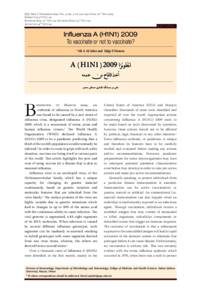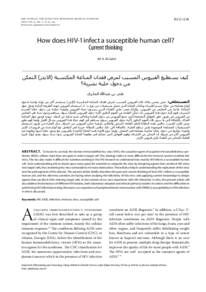Document
Influenza A (H1N1) 2009 : to vaccinate or not to vaccinate?.
Contributors
Hasson, Sidgi S., Author
Other titles
انفلونزا 2009 (H1N1) A : أخذ اللقاج من عدمه
Publisher
College of Medicine, Sultan Qaboos University.
Gregorian
2009-12
Language
English
English abstract
Beginning in March 2009, an outbreak of influenza in North America was found to be caused by a new strain of influenza virus, designated Influenza A (H1N1) 2009, which is a reassortant of swine, avian and human influenza viruses. The World Health Organization (WHO) declared Influenza A (H1N1) 2009 to be a pandemic predicting that a third of the world's population would eventually be infected. In order to come to grips with such a dire situation, vaccines are being tried in various parts of the world. This article highlights the pros and cons of using vaccine for a disease that is akin to seasonal influenza. Pregnant women, children and teens are the high risk groups who are susceptible to the clinical complications due to infection with H1N1. Such complications include death so these groups should be vaccinated no matter what.7 Other groups, however, may have some leeway to decide on vaccination or refuse it. Individuals who had a documented case of H1N1 during the 2008- 2009 influenza season have probably acquired partial immunity. But if the current strain changes between now and December, people could be highly susceptible to contracting the new virus without any immunity. Despite the decline in the pandemic, those at risk should be vaccinated in case there is a second wave of infection. Overall, development of antiviral vaccination has long been recognised as the most cost efficient use of public money in the entire health field, both in saving lives and for economic impact.
Member of
Resource URL
Arabic abstract
ابتداءً من مارس 2009 ، تم العثور على تفشي الإنفلونزا في أمريكا الشمالية بسبب سلالة جديدة من فيروس الأنفلونزا ، المعينة إنفلونزا A (H1N1) 2009 ، وهي مجموعة من فيروسات أنفلونزا الخنازير والطيور والبشر. أعلنت منظمة الصحة العالمية (WHO) أن الأنفلونزا A (H1N1) 2009 هي جائحة يتنبأ بأن ثلث سكان العالم سيصابون في النهاية. من أجل التعامل مع مثل هذا الوضع العصيب ، تجري تجربة اللقاحات في أجزاء مختلفة من العالم. تسلط هذه المقالة الضوء على إيجابيات وسلبيات استخدام لقاح لمرض يشبه الإنفلونزا الموسمية. النساء الحوامل والأطفال والمراهقون هم الفئات المعرضة لخطر الإصابة بالمضاعفات السريرية بسبب الإصابة بفيروس H1N1. تتضمن هذه المضاعفات الوفاة ، لذا يجب تطعيم هذه المجموعات مهما كان الأمر. الأفراد الذين لديهم حالة موثقة من H1N1 خلال موسم الأنفلونزا 2008-2009 قد اكتسبوا مناعة جزئية. ولكن إذا تغيرت السلالة الحالية من الآن وحتى ديسمبر ، فقد يكون الناس أكثر عرضة للإصابة بالفيروس الجديد دون أي مناعة. على الرغم من تراجع الوباء ، يجب تطعيم المعرضين للخطر في حالة حدوث موجة ثانية من العدوى. بشكل عام ، تم الاعتراف منذ فترة طويلة بتطوير التطعيم المضاد للفيروسات باعتباره الاستخدام الأكثر فعالية من حيث التكلفة للأموال العامة في المجال الصحي بأكمله ، سواء في إنقاذ الأرواح أو من أجل التأثير الاقتصادي.
Category
Journal articles


